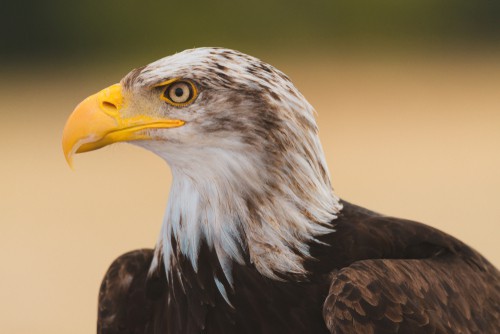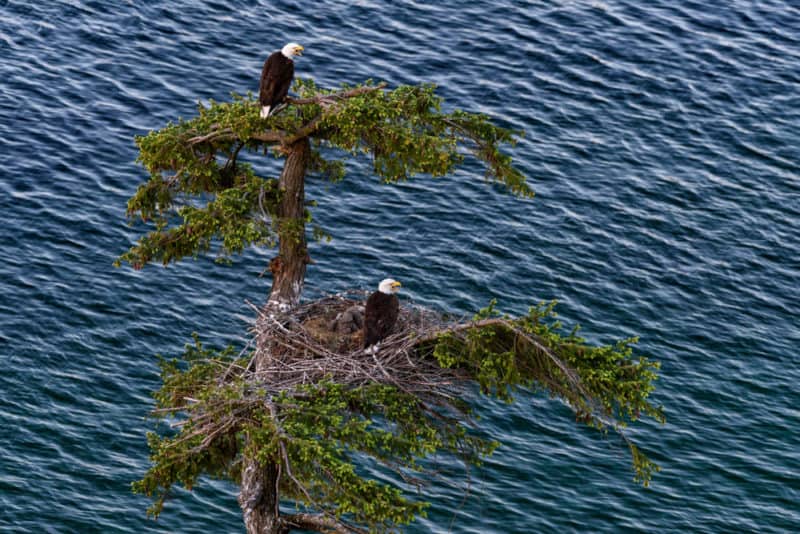Adult bald eagles are one of the most well-known and recognizable birds in North America. The distinct white feathers on their heads, yellow beaks, dark body feathers, and white tails give them a distinct look. However, many may be surprised to learn that these easily identified features aren’t shared by the young bald eagle.
So when do these great young birds get their adult plumage? What do they look like in their early years? And why do they undergo these changes? The answers reveal a fascinating look at the birds many assume they already know all too well.
When A Bald Eagle’s Head Turns White
A bald eagle gets their adult plumage in their 5th year of life.
When a baby eagle enters the world, they have a coat of down like many other birds for the first weeks of age. During that first year, the young eaglet becomes a juvenile eagle, getting a dark brown plumage complete with brown heads and a black beak.
After their first year, they become juvenile eagles. During this time, their plumage will vary greatly and likely change during these early years as they develop. They may have dark feathers for a while, but gradually, they will develop white feathers with the brown. In their fourth year, many will have largely white feather crowns, but it’s in year five that the young bald eagle really gains the classic adult pattern that’s become a national symbol in the United States.
When Do Young Eagles Develop A Yellow Beak?
All of the many traits of the adult eagle, including the yellow beak, yellow feet, and white tail feathers, develop when they are five years of age.
Do Female Bald Eagles Also Have White Heads?
Yes, the female adult eagle and male eagle have identical plumage. The only obvious difference between males and females is their size. The female eagles are much larger than their male counterparts.
There is not a definite answer on why this is. Some have speculated that it has to do with their gender roles. The male eagles leave the nest to hunt for the young eaglets. Because they fly more often to fill this role, they may need slimmer bodies to help them hunt.



Understanding The Terms Bald Eagle, Juvenile Bald Eagle, And Immature Bald Eagle
There are a lot of terms casually used when talking about these birds.
The first is the actual name of the birds. Since they have white heads, why are they called bald? Well, scientists actually refer to these birds by their Latin name, haliaeetus leucocephalus, but that has proven to be a mouthful for the average person. There are actually two things that led to the name we know them by. The first is that haliaeetus leucocephalus translates from Latin to white-headed sea eagle. The second is that in old English, the word white was often used to describe someone who was bald. These factors eventually led to us using the term bald eagle to refer to adult birds with white feathers on their head.
The terms juvenile and immature bald eagles are often used interchangeably. People may unknowingly use them to mean the same thing, so you may have to ask for clarification. However, technically, a juvenile bald eagle is the term used for when they get their first plumage. This time period is when the eaglet has lost the coat of down they first developed and now has dark feathers. An immature bald eagle has already passed their first year and now has immature plumage.

Why These Large Birds Are Spotted In The Tops Of The Tallest Trees
The bald eagle is not the largest bird in the United States, but they’re pretty high up there. The adult bald eagle has an average wingspan of 81 inches. So why do birds this large make their nests at the tops of large trees?
Bald eagles can fly very high. They use this advantage to fly to the tops of tall trees and make their nests there. This keeps them high out of the way of other predators. The eggs hatch in a safe eagle nest way up high, where they can be happily fed and cared for during these vulnerable early weeks of life.
These birds love to make their nests in tall trees near bodies of water. You’re likely to spot them flying around lakes and rivers in North America. Fortunately, they’re protected by the Wildlife Service, who do their best to see that they aren’t hunted, their habitats are preserved, and their populations can hopefully grow in the coming years.
Did Benjamin Franklin Really Hate Bald Eagles?
Fortunately, this story is actually a myth. It’s based on a letter Benjamin Franklin wrote to his daughter. In the letter, he criticized one of the early designs he had seen for the national seal. He claimed the design didn’t even look like a bald eagle, but like a turkey. He then went on to compare turkeys and bald eagles, explaining why the turkey seems to have better morals than a bald eagle. While it’s hard to tell from the written word, it does appear that he was joking in a private letter to his daughter. There is no known record of him actually taking any issue with bald eagles.
The national seal in the United States today is an illustrated representation of the bald eagle and includes the adult plumage we have come to recognize. This includes the yellow feet, yellow beak, white tail feathers, and white crown feathers.
How Much Of A Bald Eagle’s Life Is Spent With Dark Feathers On Their Head?
We’ve established that bald eagles’ crown feathers turn white in their fifth year and that they may be lighter even earlier than that. Since so many small birds live such short lives, this may make it sound like bald eagles spend a large portion of their lives with the look like immature birds. However, that’s not the case.
Wild eagles have been documented to live to 29 years old. Since the wildlife service and other agencies are only monitoring these birds to a certain point, that doesn’t necessarily mean they don’t live even longer. In fact, many believe that wild bald eagles live well into their thirties.
So if a bald eagle has immature plumage until they are five years old, they spend about 17% of its natural life with this early coloring. It’s worth noting that other eagles, like the golden eagle, have dark heads and brown feathers all their lives. Because of this, many may mistake the immature bald eagle for the golden eagle. This is likely why so few people realize that young bald eagles don’t possess the signature adult look.
Recent Posts
The only venomous snakes in Washington State are Northern Pacific Rattlesnakes. The Northern Pacific Rattlesnake (Crotalus oreganus oreganus) is a sub-species of the Western Rattlesnake. Anyone...
Skunks are not classified as true hibernators. But they go into a state of torpor when the weather gets cold. Skunks are light sleep hibernators, along with opossums, bears, and raccoons. ...

